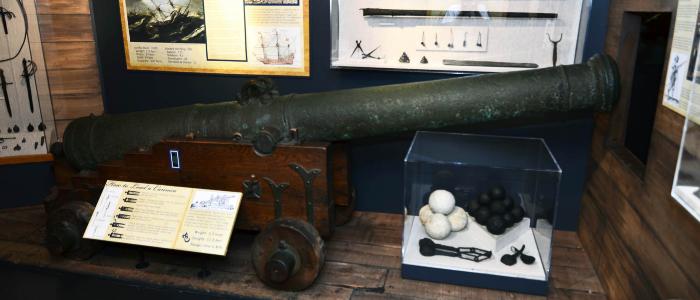Cannon
Physical Object
1987.015.0001
Santa Margarita (1622)
circa 1622
This bronze, smoothbore, muzzle-loading cannon, weighing nearly 4400 pounds, was the largest of 18 guns on Santa Margarita. It is listed on the manifest as a pieza, a generic term that simply means “piece.” The bore of the piece, though, is approximately 5 inches (130mm), and it has a bore length to diameter ratio of 24.2:1 (a measure expressed as 24.2 calibers). These dimensions qualify it as a large type of cannon called a culverin. It fired iron balls weighing between 12 and 16 pounds.
The top of the barrel has markings: the remains of what appears to be a Spanish Habsburg shield, a field that likely contained the name of the king, and a medallion that held the name of the founder and the date it was cast. These potential identifiers are all badly corroded and none are legible. Near the mid-length, at the sides of the gun, are two cylindrical trunnions. These short arms are what the gun rested on in the carriage, and they allowed it to be pivoted up and down to adjust aim. Two arching dolphin-style handles are found on the top, fixed just behind the trunnions. These dolphins are lifting handles that would have been used in getting the gun on and off the ship and in mounting it on its carriage. The knob-like appendage at the breech end, called the cascabel, was also used as a lifting device, though ropes could be looped around it during firing to prevent excessive recoil. Distinct rings of different thickness and spacing are cast along the barrel; these are called reinforces, and they delineate different stages in the taper of gun, and they helped to strengthen it against the explosive forces of gunpowder.
At the top of the gun, near the breech end, is the touchhole (or vent), and this is the point where the gunpowder charge inside the bore was ignited. Forward and off to either side of the touchhole are two additional square holes. These voids are where iron bars called “chaplets” once were. When the gun was cast, it was formed around a core insert that, when removed, created the bore. The chaplets held the core precisely in the right place. The bronze of the cannon was cast around the chaplets, and they were simply left in the gun. During the centuries under the sea, the iron of the chaplets deteriorated, leaving the holes we see today.
The top of the barrel has markings: the remains of what appears to be a Spanish Habsburg shield, a field that likely contained the name of the king, and a medallion that held the name of the founder and the date it was cast. These potential identifiers are all badly corroded and none are legible. Near the mid-length, at the sides of the gun, are two cylindrical trunnions. These short arms are what the gun rested on in the carriage, and they allowed it to be pivoted up and down to adjust aim. Two arching dolphin-style handles are found on the top, fixed just behind the trunnions. These dolphins are lifting handles that would have been used in getting the gun on and off the ship and in mounting it on its carriage. The knob-like appendage at the breech end, called the cascabel, was also used as a lifting device, though ropes could be looped around it during firing to prevent excessive recoil. Distinct rings of different thickness and spacing are cast along the barrel; these are called reinforces, and they delineate different stages in the taper of gun, and they helped to strengthen it against the explosive forces of gunpowder.
At the top of the gun, near the breech end, is the touchhole (or vent), and this is the point where the gunpowder charge inside the bore was ignited. Forward and off to either side of the touchhole are two additional square holes. These voids are where iron bars called “chaplets” once were. When the gun was cast, it was formed around a core insert that, when removed, created the bore. The chaplets held the core precisely in the right place. The bronze of the cannon was cast around the chaplets, and they were simply left in the gun. During the centuries under the sea, the iron of the chaplets deteriorated, leaving the holes we see today.
